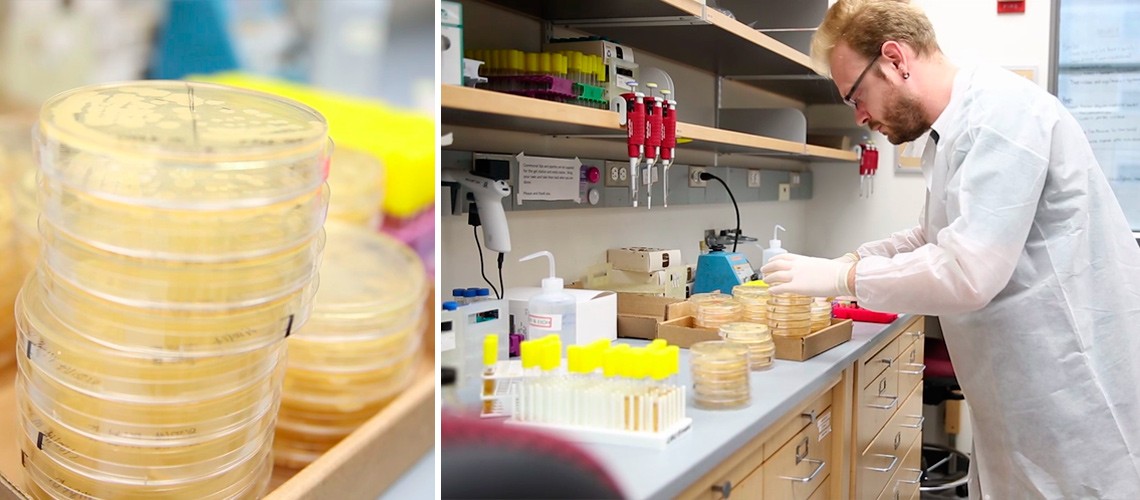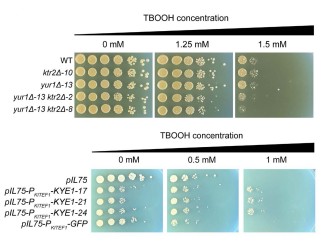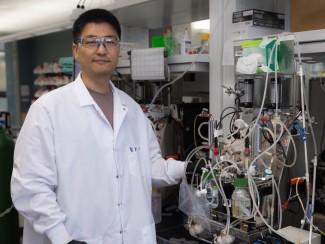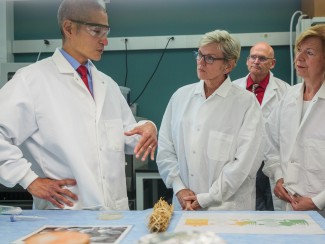
In a state rich with beer-making history, UW-Madison scientists are getting to the bottom of an age-old fermentation puzzle that could enlighten both brewers and biofuel researchers.
Chris Todd Hittinger, an assistant professor of genetics and a researcher with the Great Lakes Bioenergy Research Center (GLBRC), has won a National Science Foundation Faculty Early Career Development (CAREER) award to study how Saccharomyces yeasts—which are responsible for fermenting sugars into the ethanol found in wine, beer and biofuel—adapt over time to industrial conditions. The project’s findings could help researchers develop new yeast strains that not only produce biofuel efficiently, but also thrive in a bio-refinery environment.
The project follows up on the recent discovery of a South American yeast species called Saccharomyces eubayanus, which represents a missing link for both yeast taxonomists and beer enthusiasts. S. eubayanus is one genetic parent of a well known hybrid yeast used to make lager beer. The hybrid’s other parent is Saccharomyces cerevisiae—which is also, as Hittinger puts it, the “workhorse of the biofuel industry.”
“People have known that lager beer was brewed with a hybrid for a long time, and that one half was S. cerevisiae,” says Hittinger.
“Now that we have identified both parents, we can compare genetic and physiological data to find out which species has contributed which traits to the hybrid, and how this genetic variation plays a role in domesticating yeast.”
A lot of people think that if you've seen one yeast you've seen them all. But if we look at their DNA sequences, within the genus Saccharomyces we're seeing a level of genetic divergence that is roughly equal to that between a human and a chicken.
Chris Todd Hittinger
Interestingly, from examining a large selection of S. eubayanus strains collected from Argentina, Hittinger and his team think that the new species is extremely genetically diverse. The hope, he says, is that this variation will be useful for researchers interested in selecting strains for certain industry-friendly characteristics.
“A lot of people think that if you've seen one yeast you've seen them all,” says Hittinger. “But if we look at their DNA sequences, within the genus Saccharomyces we're seeing a level of genetic divergence that is roughly equal to that between a human and a chicken."
Of all the ways in which the different yeast strains vary, the researchers are most interested in a few key traits, one of which is temperature preference. Hittinger explains that while ancestral Saccharomyces yeasts preferred cooler climates, others—like the biofuel yeast S. cerevisiae—have evolved to thrive in warmer temperatures above 80 degrees Fahrenheit. Understanding the genetic mechanism for this adaptation is one path to identifying new heat-tolerant yeasts, which are essential for high-temperature industrial processes.
Another yeast trait with unique implications for bioenergy is resistance to toxins produced by the chemical treatments researchers use to deconstruct plant material prior to biofuel processing.
“Because we are looking at extremely divergent Saccharomyces species, as we start to test individual components of these toxins, we'll start to find the genes that give tolerance to them,” says Hittinger.
To answer these questions, Hittinger and his team are applying modern scientific methods to ancient processes that have, for reasons unknown to their original developers, ‘worked’ well for centuries.
“Brewers and winemakers who were using hybrid yeast strains in the 16th century had no idea what they were doing,” says Hittinger.
“What we see over and over again is that hybrids are coming out of these industrialized processes as the most effective strains, and we think that we can do much of the same thing with the biofuel industry. By crossing new species with industrial strains GLBRC has already created, we’re trying to accelerate these processes in the lab instead of waiting for fortuitous hybrids to happen.”
In addition to lager yeast, Hittinger and his team will be looking at Saccharomyces diversity more broadly during the five-year CAREER project with the help of high school and college students. The Wild Yeast Exploration and Analysis Science Team (YEAST) Program is the education and outreach component of the grant that invites students to learn how to isolate and identify new yeast strains using molecular genetics and bioinformatics techniques. In future years, there are funds for a high school teacher to train in the lab and develop activities for the classroom.
“We are excited because we already have nearly 1,000 strains that have been collected by high school students and undergrads through the Wild YEAST Program,” says Hittinger.
“A broader understanding of yeast biodiversity is important because some species make oil droplets rather than ethanol. These are the kinds of species we should be thinking about in terms of next-generation biofuels.”





